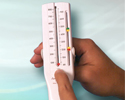Make peak flow a habit
Asthma - make peak flow a habit; Reactive airway disease - peak flow; Bronchial asthma - peak flow
Checking your peak flow is one of the best ways to monitor your asthma and to keep it from getting worse.
Asthma attacks do not usually come on without warning. Most times, they build slowly. Checking your peak flow can tell you if an attack is coming, sometimes before you have any symptoms.
What is Peak Flow?
Peak flow (Liters per second) can tell you how well you blow air out of your lungs. If your airways are narrowed and blocked due to asthma, your peak flow values drop.
You can check your peak flow at home with a small, plastic meter. Some meters have tabs on the side that you can adjust to match your action plan zones (green, yellow, red). If your meter does not have these, you can mark them with colored tape or a marker.
Write Down Your Peak Flow Numbers
Write down your peak flow scores (numbers) on a chart or diary. Many brands of peak flow meters come with charts. Make a copy of your chart to bring with you when you see your health care provider.
Next to your peak flow number also write:
- Date and time of your measurement and any signs or symptoms you felt.
- Steps you took if you had symptoms or your peak flow dropped.
- Changes in your asthma medicines.
- Any asthma triggers you were exposed to.
Use Your Peak Flow Meter Every Day
Once you know your personal best, take your peak flow:
- Every morning when you wake up, before you take medicine. Make this part of your daily morning routine.
- When you have asthma symptoms or an attack.
- Again after you take medicine for the attack. This can tell you how bad your asthma attack is and if your medicine is working.
- Any other time your provider tells you to.
Check to see which zone your peak flow number is in. Do what your provider told you to do when you are in that zone. This information should be in your action plan.
Do your peak flow 3 times and record the best value every time you check it.
If you use more than one peak flow meter (such as one at home and another one at school or work), be sure that all of them are the same brand.
References
Boulet LP, Godbout K. Diagnosis of asthma in adults. In: Burks AW, Holgate ST, O'Hehir RE, et al, eds. Middleton's Allergy: Principles and Practice. 9th ed. Philadelphia, PA: Elsevier; 2020:chap 51.
Chassay CM. Pulmonary function testing. In: Fowler GC, ed. Pfenninger and Fowler's Procedures for Primary Care. 4th ed. Philadelphia, PA: Elsevier; 2020:chap 81.
Mcdowell KM, Mokhallati N. Wheezing in older children: asthma. In: Bush A, Deterding R, Li AM, et al, eds. Kendig' and Wilmott’s Disorders of the Respiratory Tract in Children. 10th ed. Philadelphia, PA: Elsevier; 2024:chap 36.
Miller A, Nagler J. Devices for assessing oxygenation and ventilation. In: Roberts JR, Custalow CB, Thomsen TW, eds. Roberts and Hedges' Clinical Procedures in Emergency Medicine and Acute Care. 7th ed. Philadelphia, PA: Elsevier; 2019:chap 2.
National Heart, Lung and Blood Institute website. Asthma Management Guidelines: Focused Updates 2020. www.nhlbi.nih.gov/health-topics/asthma-management-guidelines-2020-updates. Updated February 4, 2021. Accessed February 9, 2024.
National Heart, Lung and Blood Institute website. How to use a metered-dose inhaler fact sheet. www.nhlbi.nih.gov/resources/how-use-metered-dose-inhaler-fact-sheet. Updated October 2021. Accessed February 9, 2024.
Vishwanathan RK, Busse WW. Management of asthma in adolescents and adults. In: Burks AW, Holgate ST, O'Hehir RE, et al, eds. Middleton's Allergy: Principles and Practice. 9th ed. Philadelphia, PA: Elsevier; 2020:chap 52.
Review Date: 2/3/2024
Reviewed By: Frank D. Brodkey, MD, FCCM, Associate Professor, Section of Pulmonary and Critical Care Medicine, University of Wisconsin School of Medicine and Public Health, Madison, WI. Also reviewed by David C. Dugdale, MD, Medical Director, Brenda Conaway, Editorial Director, and the A.D.A.M. Editorial team.


